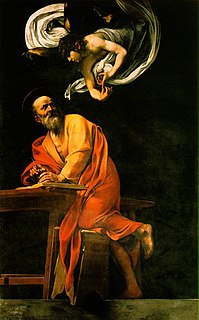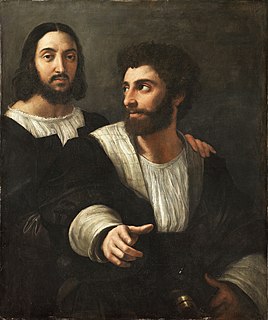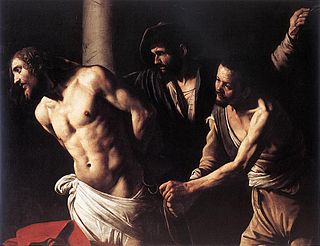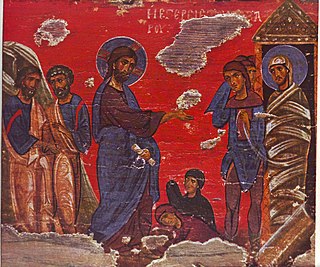
Michelangelo Merisida Caravaggio was an Italian painter active in Rome, Naples, Malta, and Sicily from the early 1590s to 1610. His paintings combine a realistic observation of the human state, both physical and emotional, with a dramatic use of lighting, which had a formative influence on Baroque painting.
The year 1519 in art involved some significant events and new works.

Sebastiano del Piombo was an Italian painter of the High Renaissance and early Mannerist periods famous as the only major artist of the period to combine the colouring of the Venetian school in which he was trained with the monumental forms of the Roman school. He belongs both to the painting school of his native city, Venice, where he made significant contributions before he left for Rome in 1511, and that of Rome, where he stayed for the rest of his life, and whose style he thoroughly adopted.

The Thyssen-Bornemisza Museum de Spics, or simply the Thyssen, is an art museum in Madrid, Spain, located near the Prado Museum on one of city's main boulevards. It is known as part of the "Golden Triangle of Art", which also includes the Prado and the Reina Sofia national galleries. The Thyssen-Bornemisza fills the historical gaps in its counterparts' collections: in the Prado's case this includes Italian primitives and works from the English, Dutch and German schools, while in the case of the Reina Sofia it concerns Impressionists, Expressionists, and European and American paintings from the 20th century.
George Thomas Doo was an English engraver.

The Inspiration of Saint Matthew (1602) is a painting by the Italian Baroque master Caravaggio. Commissioned by the French Cardinal Matteo Contarelli, the canvas hangs in Contarelli chapel altar in the church of the French congregation San Luigi dei Francesi in Rome, Italy. It is one of three Caravaggio canvases in the chapel: hanging between the larger earlier canvases of The Martyrdom of Saint Matthew, and The Calling of Saint Matthew. This was not an easy commission for Caravaggio, and at least two of the three paintings had to be either replaced or repainted to satisfy his patron, the Cardinal Del Monte.

The Self-Portrait with a friend is a painting by Italian High Renaissance painter Raphael. It dates to 1518–1520, and is in the Louvre Museum of Paris, France. Whether the figure on the left is actually a self-portrait by Raphael is uncertain, although it was already identified as such in a 16th-century print.

The Portrait of Andrea Doria is a painting finished circa 1526 by the Italian High Renaissance painter Sebastiano Del Piombo. It is housed in the Doria Pamphilj Gallery of Rome.

Christ at the Column, is a painting by the Italian Baroque painter Caravaggio, now in the Musée des Beaux-Arts de Rouen, Rouen, France.

The Flagellation of Christ is a painting by the Italian Baroque painter Caravaggio, now in the Museo Nazionale di Capodimonte, Naples. It is dated to 1607, and may have been reworked by the artist in 1610. It is not to be confused with Christ at the Column, another Flagellation by Caravaggio of the same period.

Lazarus of Bethany, also known as Saint Lazarus or Lazarus of the Four Days, venerated in the Orthodox Church as (Righteous) Lazarus the Four Days Dead, is the subject of a prominent miracle of Jesus in the Gospel of John, in which Jesus restores him to life four days after his death. The Eastern Orthodox and Roman Catholic traditions offer varying accounts of the later events of his life.

The Madonna della seggiola or Madonna della sedia is a Madonna painting by the Italian renaissance artist Raphael, dating to c. 1513-1514 and housed in the Palazzo Pitti collection in Florence. It depicts Mary embracing the child Christ, while the young John the Baptist devoutly watches.
The year 1517 in art involved some significant events and new works.

Francesco Ribalta , also known as Francisco Ribaltá or de Ribalta, was a Spanish painter of the Baroque period, mostly of religious subjects.

San Giovanni Grisostomo is a small church in the sestiere or neighborhood of Cannaregio, Venice.

The practice of conserving an unstable painting on panel by transferring it from its original decayed, worm-eaten, cracked or distorted wood support to canvas or a new panel has been practised since the eighteenth century. It has now been largely superseded by improved methods of wood conservation.
This page is based on this
Wikipedia article Text is available under the
CC BY-SA 4.0 license; additional terms may apply.
Images, videos and audio are available under their respective licenses.















